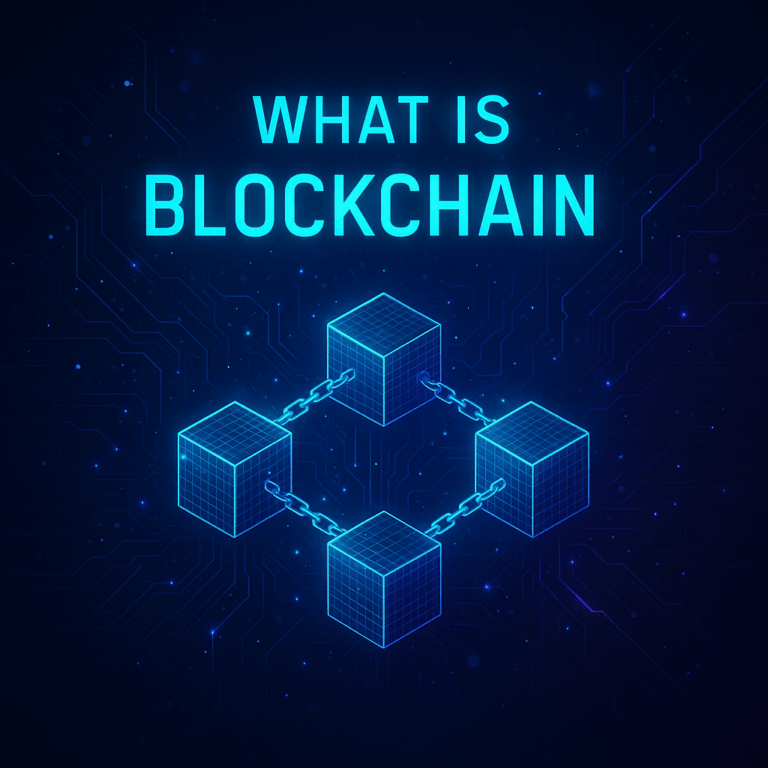
our blogs
What is Blockchain ?

What is Blockchain ? A-step-by-Step Comprehensive Guide
Blockchain technology is reshaping how digital transactions work and creating new opportunities for trustless systems across the world.
has been among the hottest topics recently. But what is blockchain, how does it work, and why is it so important? In this article, we’ll explain blockchain in simple words, talk about its uses, and go over its future potential. For more Web3 solutions, you can visit UNCW3B
What is Blockchain ?
The word “blockchain” literally translates to “chain of blocks.” It is a method of recording digital transactions in a secure, decentralized, and transparent way. Every transaction is stored as a block and cryptographically linked to the previous one, in a perpetual chain. Blockchain technology continues to evolve, powering innovations beyond cryptocurrencies.
The most important feature of blockchain is its immutability — information, once added, cannot be altered or manipulated. Unlike traditional financial systems, where transactions are verified by central authorities, blockchain relies on a network of computers that are decentralized.
Learn more about blockchain technology on the official Binance Academy page.
How Does Blockchain Work ?
When a user wants to send digital assets to another user, the transaction is broadcast to the entire network. Computers on the network (called nodes) confirm the transaction using complex mathematical algorithms. The confirmation process is called a consensus mechanism.
The transaction, after being verified, is fashioned into a new block and appended to the previous chain. Each. block refers to the previous one, and thereby the chain continues to grow. To manipulate the system, one would need to alter not just one block but the entire chain, which is practically impossible.
Advantages of Blockchain
Security:
Blockchain stores all data in blocks that are and ypted using
keeps it hidden developed cryptographic algorithms. Since this data is distributed across thousands of independent computers (nodes) instead of a single central server, there is no point of failure. Even if one or more nodes are hacked, the overall system remains secure, and blockchain is virtually unfeasible to hack into or alter.
Transparency:
“Blockchain technology secures data with cryptographic links between blocks.”
Blockchain stands out because it provides full transparency as one of its most powerful attributes. Each blockchain transaction exists in a public ledger that allows general viewing at any time. Blockchain differs from standard financial systems because it keeps all transaction information freely accessible to everyone without central authority control.
Investors together with users and businesses can immediately track the origin and destination of funds through transparent records. The clarity between parties generated through transparency leads to decreased fraud risks and corruption risks. Through blockchain technology customers gain the ability to follow every step of a product’s journey from raw materials until they receive their purchase. Financial institutions utilize blockchain to detect and prevent both secret tampering and illegal modifications.
Blockchain transparency enables organizations together with individuals to obtain certain confirmation that displayed information remains authentic and unalterable and stands beyond human interference.
Decentralization:
At the core of blockchain lies the principle of decentralization.The traditional systems which operate under a central authority system differ from blockchain because they place control and power under banks and governments and corporations yet blockchain spreads these responsibilities among independent network participants called nodes. The system operates independently from any organization that would attempt to control or shut it down.
The network reaches transaction validation through majority approval which operates as consensus mechanisms to distribute power in decentralized systems. The system establishes a democratic structure which lets people handle their assets directly without needing third-party involvement.
Users in finance can send money to each other directly without any banking involvement. A single entity lacks the power to remove or block data during information sharing processes. The governance sector adopts decentralized networks to form DAOs which function as community voting systems for deciding project development directions.
The transition from centralized control to distributed power systems brings advantages for security and resilience and creates possibilities for industrial innovation.
Speed & Efficiency:
Blockchain truly stands out when it comes to speed and efficiency.The process of international payment through traditional banking systems requires multiple days to complete. The payment process encounters delays because it must go through multiple financial institutions while banks operate during limited hours and time zones create additional obstacles.
With blockchain, all of that waiting disappears.The verification process occurs immediately so that transactions become part of the chain. The settlement speed of blockchains varies between networks because some networks process transactions within minutes but others achieve settlement times below one second.
Blockchain technology extends its value beyond financial transactions because people can use it to transfer more than just money. Smart contracts enable automatic task execution when specified conditions occur which eliminates the need for human involvement. Imagine an insurance claim. The traditional system demanded several weeks for processing. Smart contracts on blockchain platforms allow immediate payment release when the predefined conditions reach fulfillment.
Cost Reduction:
The primary benefit of blockchain technology shows itself through the financial savings it produces. Every financial transaction within traditional banking systems requires passing through middlemen which include banks and payment providers and clearing houses. Every service takes a percentage of the transaction as fees which accumulate rapidly when sending money overseas.
Blockchain eliminates the requirement for most intermediaries to exist. The direct transactions between parties on a decentralized network result in major cost reductions. The fees for bank transfers to foreign countries generally range from thirty to fifty dollars yet blockchain networks provide almost free transfers with near zero costs.
This isn’t only about payments.Businesses that use blockchain-based smart contracts achieve cost savings through the reduction of manual paperwork and legal expenses and faster processing times. The system functions without middlemen and eliminates bureaucratic procedures to protect your funds from being taken away.
Where is Blockchain Used ?
Blockchain is changing the future of not only cryptocurrencies but also of several industries. Below are the most common use cases:
1. Cryptocurrencies
The most well-known use of blockchain is cryptocurrencies. Bitcoin, Ethereum, and hundreds of altcoins all use blockchain technology. As opposed to conventional banking, where transactions can take days and pass through several intermediaries, blockchain lends itself to inexpensive transactions within minutes — anywhere in the world.
2. Smart Contracts
Smart contracts are digital contracts that automatically carry out the execution when the predefined conditions are met. For example, payment can be made to the seller automatically on the delivery of a product. This removes the requirement of legal or notary intermediaries. Smart contracts find more use in e- commerce, logistics, and finance today.
3. Finance and Banking
Traditional cross-border payments through networks like SWIFT can take days and are costly. Blockchain reduces this to just minutes and at a lower cost. Banks can also use blockchain for loans, customer. verification, and payment flows — securely and more efficiently. Because of this, the majority of major f inancial institutions put money into blockchain initiatives.
4. Healthcare
Blockchain can revolutionize healthcare by safeguarding patient data. Medical records can be stored safely on a chain and accessed only by the authorized people. It prevents data breaches and also gives quick access to the patient’s history across hospitals or even countries. For example, when a patient visits a doctor in a foreign country, their whole medical record can be accessed in a flash.
5. Gaming and NFTs
One of the most promising applications of blockchain is in gaming and NFTs. In-game assets — characters, skins, or weapons — can be stored as NFTs, giving players true ownership. Digital collectibles, art, and music are also being traded as NFTs, secured on the blockchain. This opens up new possibilities for artists and collectors to monetize and secure digital property.
The Future of Blockchain
Web3: Decentralizes the internet and makes it user-centric.
Conclusion

